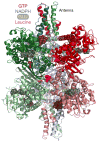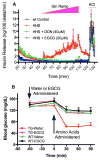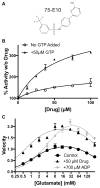Glutamate Dehydrogenase, a Complex Enzyme at a Crucial Metabolic Branch Point
- PMID: 29079932
- PMCID: PMC5924581
- DOI: 10.1007/s11064-017-2428-0
Glutamate Dehydrogenase, a Complex Enzyme at a Crucial Metabolic Branch Point
Abstract
In-vitro, glutamate dehydrogenase (GDH) catalyzes the reversible oxidative deamination of glutamate to α-ketoglutarate (α-KG). GDH is found in all organisms, but in animals is allosterically regulated by a wide array of metabolites. For many years, it was not at all clear why animals required such complex control. Further, in both standard textbooks and some research publications, there has been some controversy as to the directionality of the reaction. Here we review recent work demonstrating that GDH operates mainly in the catabolic direction in-vivo and that the finely tuned network of allosteric regulators allows GDH to meet the varied needs in a wide range of tissues in animals. Finally, we review the progress in using pharmacological agents to activate or inhibit GDH that could impact a wide range of pathologies from insulin disorders to tumor growth.
Keywords: Allostery; Glutamate dehydrogenase; Insulin.
Figures








Similar articles
-
The structure and allosteric regulation of mammalian glutamate dehydrogenase.Arch Biochem Biophys. 2012 Mar 15;519(2):69-80. doi: 10.1016/j.abb.2011.10.015. Epub 2011 Nov 4. Arch Biochem Biophys. 2012. PMID: 22079166 Free PMC article. Review.
-
Glutamate dehydrogenase is essential to sustain neuronal oxidative energy metabolism during stimulation.J Cereb Blood Flow Metab. 2018 Oct;38(10):1754-1768. doi: 10.1177/0271678X17714680. Epub 2017 Jun 16. J Cereb Blood Flow Metab. 2018. PMID: 28621566 Free PMC article.
-
Regulation of human glutamate dehydrogenases: implications for glutamate, ammonia and energy metabolism in brain.J Neurosci Res. 2001 Dec 1;66(5):899-908. doi: 10.1002/jnr.10054. J Neurosci Res. 2001. PMID: 11746417 Review.
-
Glutamate dehydrogenase: structure, allosteric regulation, and role in insulin homeostasis.Neurochem Res. 2014;39(3):433-45. doi: 10.1007/s11064-013-1173-2. Epub 2013 Oct 12. Neurochem Res. 2014. PMID: 24122080 Free PMC article. Review.
-
Glutamate Dehydrogenase as a Neuroprotective Target Against Neurodegeneration.Neurochem Res. 2019 Jan;44(1):147-153. doi: 10.1007/s11064-018-2467-1. Epub 2018 Jan 22. Neurochem Res. 2019. PMID: 29357018 Review.
Cited by
-
Localization of Human Glutamate Dehydrogenases Provides Insights into Their Metabolic Role and Their Involvement in Disease Processes.Neurochem Res. 2019 Jan;44(1):170-187. doi: 10.1007/s11064-018-2575-y. Epub 2018 Jun 25. Neurochem Res. 2019. PMID: 29943084 Review.
-
Postprandial Metabolomic Profiling: Insights into Macronutrient-Specific Metabolic Responses in Healthy Individuals.Nutrients. 2024 Nov 4;16(21):3783. doi: 10.3390/nu16213783. Nutrients. 2024. PMID: 39519617 Free PMC article. Clinical Trial.
-
A non-redundant role of EAAT3 for ATP synthesis mediated by GDH in dopaminergic neuronal cells: a new avenue for glutamate metabolism and protection in Parkinson's disease.FEBS J. 2025 Jun;292(12):3224-3241. doi: 10.1111/febs.70053. Epub 2025 Mar 5. FEBS J. 2025. PMID: 40045666 Free PMC article.
-
Structural Evolution of Primate Glutamate Dehydrogenase 2 as Revealed by In Silico Predictions and Experimentally Determined Structures.Biomolecules. 2023 Dec 23;14(1):22. doi: 10.3390/biom14010022. Biomolecules. 2023. PMID: 38254622 Free PMC article.
-
A ketogenic diet alters mTOR activity, systemic metabolism and potentially prevents collagen degradation associated with chronic alcohol consumption in mice.Metabolomics. 2023 Apr 19;19(5):43. doi: 10.1007/s11306-023-02006-w. Metabolomics. 2023. PMID: 37076659 Free PMC article.
References
-
- Hudson RC, Daniel RM. L-Glutamate dehydrogenases: distribution, properties and mechanism. Comp Biochem Physiol. 1993;106B:767–792. - PubMed
-
- Frieden C. Glutamate dehydrogenase VI: survey of purine nucleotides and other effects on the enzyme from various sources. J Biol Chem. 1965;240:2028–2037. - PubMed
-
- Frieden C. Glutamic dehydrogenase I. The effect of coenzyme on the sedimentation velocity and kinetic mechanism. J Biol Chem. 1959;234:809–814. - PubMed
-
- Tomkins GM, Yielding KL, Curran JF. The influence of diethylstilbestrol and adenosine diphosphate on pyridine nucleotide coenzyme binding by glutamic dehydrogenase. J Biol Chem. 1962;237:1704–1708. - PubMed
-
- Bailey JS, Bell ET, Bell JE. Regulation of bovine glutamate dehydrogenase. J Biol Chem. 1982;257:5579–5583. - PubMed
Publication types
MeSH terms
Substances
Grants and funding
LinkOut - more resources
Full Text Sources
Other Literature Sources

